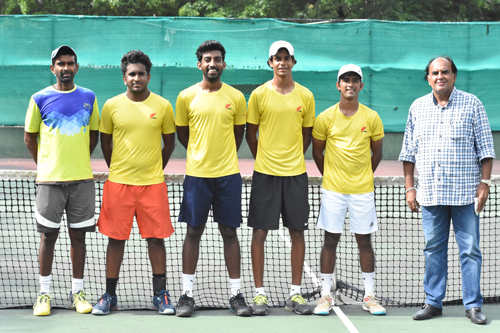Davis Cup, Nations Cup, Laver Cup and our tennis
View(s):
Sri Lanka Davis Cup team for 2021, prior to the departure to Amman, Jordan
All of these names are global annual tennis team competitions for men. Women’s tennis has another set of competition. Rather complicating even to a player/enthusiast who has been following global completion tennis for 50 years.
The inevitable question, what are they? Is it about which body controls global tennis, or who should make the money or who has the upper edge of the game or who is enjoying the top position or media attraction or devices to propagate tennis globally?
New level in challenges
With the appearance of WTA and ATP, global tennis has changed, but Sri Lanka has not changed approach to the game of tennis. The change is necessity to perform adequately in international platforms.
Over 180 nations took to tennis team making process in the last 100 years. Davis Cup was the propellant. Sri Lanka is one of them. Going by the result of our performance in Davis Cup in Amman, Jordan two weeks ago, it is inevitable but to ask, what is happening? Okay, we went down to the bottom group because of few valid reasons. Even otherwise, at best we would have remained in Group 3. This is after playing Davis Cup for over 50 years. Most of the countries in Amman did not play Davis Cup 50 years ago. We were the most senior nation in Amman draw. Literally, the programmes we have yields positions not players.
Crust of the matter lies in our lack of understanding the changes that has occurred in the global tennis competition platforms and the standards required to be there.
WTA, ATP and ITF
WTA conducts annual tennis tournaments round the year in all continents and Billie Jean King Cup as their global team event championships. ATP is the same and Nation’s Cup is their equivalent. These two are for countries with elite professional players in the top 100 in the WTA/ATP individual world ranking. The qualification is by the number of top 50 players a nation has in the professional ranking. It is not automatic. They make sure the standard of tennis exhibited is appealing to the world.
Adding to this is the Rod Laver/Roger Federer set up the Laver Cup. All of these are exhibition tennis at its best. Tennis can be very attractive and appealing to watch in these events when players well matched. As good as Grand Slam events final rounds. These have made Davis Cup to be of lesser global attraction. I will be not wrong to say, Davis Cup has served its time well. In fact, very well in taking tennis around the world. Now time for nations to move on.
A good 80% of the countries in the world cannot play in WTA’s Billie Jean Cup and in ATP’s Nations Cup. They do not develop players of that caliber in their home grounds. Even to get Davis Cup player status ITF insist at least one win in Group 2 of Davis Cup competition. All who mode into Davis Cup team are not Davis Cup Players. ITF is also trying to make the status of Davis Cup player look good.
Sports good manufacturing companies are the sponsors of ITF. Junior development of countries gives players in numbers to sell equipment. Elite development does not give numbers. Taking this matter as fact, we should look at WTA and ATP to develop our elites. This has to happen in Sri Lanka.
Junior development is very heavily resource consuming and is mere elementary sports schooling process. To make good Davis Cup team a nation need more than this. We need adult players.
Our British model club system was far more effective in development. What happened to that? All current junior development programmes did not create new playing facilities but took over the club facilities.
Junior development activity was in schools before. After that, for our players clubs tennis was the intermediate standard between schools standard and national standard. Tennis competition is not about stroke making but being tactical. Tennis players play using full-fledged scoring. Tennis activity participants play with modified scoring. It does not contribute to all important mental competition development.
Back to the drawing board again.
Emma Raducanu time
In global tennis, it is now Emma Raducanu time. Names changed in women’s tennis very fast after Serena Williams and Maria Sharapova era. Raducanu is still a Grand Slam one timer already with royal company, changing coaches and a big time money spinner.
Britain did not have one like Raducanu in 40 years. In England, it is a carnival. All old names are getting a chance to relive part of the prominence they used to have. Virginia Wade, Tim Henman and others had their names in the media after a good many years. Each player have plus point to perform so well, Raducanu’s multisport background had mentally matured her into competition and it is proving to be a big asset.
Thinking outside the box
Doing other sports helps immensely. Known as cross training in development and is very much emphasised. Current world’s number one, Ashleigh Barty, was an Australian cricket prospect. Most of the USA players were basketball players. Barty too changed the coach to achieve her current position. Development coaches are not good tactical coaches. Time again this has proved to be so. Changes also give fresh inspirations and ideas outside the box.
—George Paldano, Former international player; accredited coach of German Tennis Federation; national coach Brunei and Sri Lanka, coached ATP, WTA and ITF 200 ranked players and Davis Cup, Federation Cup coach. — geodano2015@gmail.com


